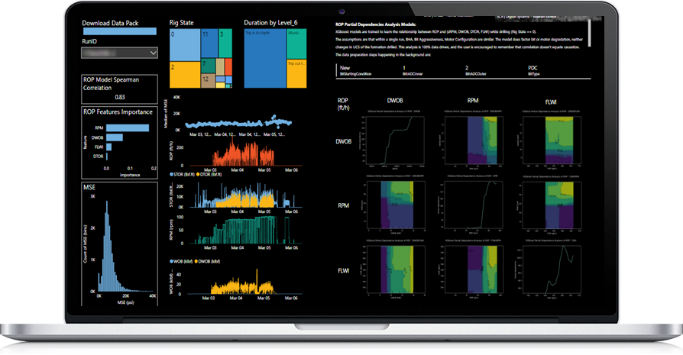How we deploy machine learning to rapidly reduce drilling times
Having been closely involved in rig operations for a large part of my career, I have spent several sleepless nights agonizing over the consequences of judgement calls I had made. I’m sure others feel the same; as ‘drillers’, us well engineers, field supervisors and drilling superintendents are required to navigate endless dilemmas daily:
Are we drilling fast enough?
Should we perform a bit trip now?
Is this even the right bit and bottom hole assembly (BHA)?
Are we heading into a loss zone?
The list goes on and I’m sure you could add more. Traditionally, drillers have honed our ‘third eye’ through years of experience and lessons learned the hard way. Tough decisions were made counting on the team’s collective memory of how similar situations were dealt with in the past. At times one just had to make bets based on intuition and whims. From my time drilling in Saudi Arabian sands, I distinctly remember the sinking feeling I got after misjudging bit conditions and prematurely performing BHA trips.
Today, as the E&P industry evolves faster than ever before, the margin for error keeps getting narrower. Efficiency gains are no longer factored in as potential upsides. They are now necessary for market survival. Additionally, as the workforce gets younger, domain experts with decades of experience are becoming a rare breed. In the face of such challenges, how do we go about delivering consistent performance improvement? The answer for many industries has been AI, and it’s quickly gaining greater acceptance and adoption in energy industry domains, such as drilling.
Technology, similar to that which Amazon uses to suggest products you may wish to buy, is now revolutionizing drilling. Computers are trained to recognize patterns, classify images, anticipate behavior by analyzing vast streams of data. They learn from large chunks of data and use these ‘lessons’ to either predict the outcome in a certain environment or suggest the environmental boundaries most likely to lead to certain outcomes. While the human brain may be able to guess the impact of tweaking one or two variables, a machine learning model can do the same with hundreds in a fraction of the time. Herein lies the inherent value of AI in drilling.
How exactly can drilling teams leverage AI?
A good start would be to acknowledge and appreciate the treasure trove of drilling and subsurface data at our disposal. Operators have been logging subsurface data with varying degrees of granularity across geographies. Several terabytes of seismic data acquired over the years hold invaluable information about reservoir properties. Additionally, in practically every well drilled, operators have been recording time series data of surface parameters such as weight-on-bit (WOB), rotations per minute (RPM), drilling fluid flow rates, torque, etc. in tandem with formation response in the form of rate of penetration (ROP), shocks and vibrations (S&V), hydrocarbon shows. A lot of valuable metadata can also be gleaned from daily drilling reports and drilling run summaries.
Data scientists begin by cleaning the data followed by splitting it into ‘training data’ and ‘validation data’. Training data is the subset that is used to build the machine learning model for gaining insights about data behavior. The next step is to evaluate the model by testing its accuracy using the validation data. The process typically involves iterating multiple machine learning algorithms till one arrives at a model that meets the required success criteria.
At INNOVATION FACTORI, we’re collaborating with operators across geographies to prioritize use cases and apply AI to address challenges in areas such as well construction planning, operations, HSE, process digitization and many more. One such successful project that is a personal favorite of mine due to its location agnostic applicability is the Drilling Parameters Recommender.

Fig. 1 Drilling Parameters Recommender
Drilling Parameters Recommender
Drilling makes up roughly 50% of the typical well construction time, while flat time activities contribute to the rest. Several operators list subpar ROP as one of the primary reasons adversely affecting well construction times. A few Schlumberger customers also mentioned the difficulty they faced in repeating record-breaking drilling runs in wells that were just meters apart. A high degree of inconsistency was observed in drilling ROP with factors such as driller’s bias, absence of field-specific guidelines leading to suboptimal performance and escalation of costs. A few brainstorming sessions with drilling experts identified the need to have detailed surface drilling parameter roadmaps that could be utilized by drillers as the operating windows most likely to maximize ROP.
To come up with a meaningful solution, it is crucial to take into consideration ROP trends observed with different sets of surface drilling parameters applied in offset wells. However, building such roadmaps manually can be extremely time consuming and resource intensive in big fields with hundreds of wells consisting of thousands of sections. We were able to circumvent this challenge by automating the analysis, to minimize manual input while still ingesting and processing a large volume of data. Machine learning algorithms that have been tested by Schlumberger with data from historical wells from across the globe were applied to analyze offset wells to provide the appropriate boundaries of drilling parameters for future wells. The output is a customized, intuitive visualization dashboard that is used by engineering and operations personnel to help make informed decisions in the field.
The seven regional INNOVATION FACTORI centers are staffed with teams working on rapid development and deployment of data-centric solutions for customers. I certainly wish I had access to such multidisciplinary experts during my well engineering days. The industry has just begun to scratch the surface of a plethora of opportunities that are waiting to be unlocked by greater AI adoption. The onus of coming up with fresh ideas lies firmly with domain experts who have first-hand experience of dealing with drilling challenges. Their steadfast support and proactive involvement are imperative for the analytics experts to develop meaningful workflows that genuinely create value. I believe focused resources, such as the INNOVATION FACTORI, can significantly accelerate the digital transformation of the energy industry, and I hope many of us are prepared to adapt quickly and jump on the digital train to a promising future!
Author information: Soumil is the Global Innovation Manager for Drilling as part of Schlumberger’s INNOVATION FACTORI HQ team. Since joining Schlumberger in 2012, Soumil has held a variety of positions spanning well engineering, wellsite supervision, project management and business development for integrated drilling projects with customers. In his current capacity, he has been focused on working closely with operators in addressing drilling related challenges leveraging Schlumberger’s Data Science, AI and drilling domain expertise. Soumil holds a B.Tech.-M.Tech. in Chemical Engineering from the Indian Institute of Technology Kanpur.
Disclaimer: All opinions expressed by the blog contributors are solely their current opinions and do not reflect the opinions of Schlumberger or its affiliates. The blog's opinions are based upon information they consider reliable, but neither Schlumberger nor its affiliates warrant its completeness or accuracy, and it should not be relied upon as such.

